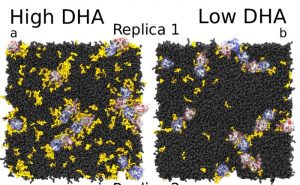Date/Time
Date(s) - 11/05/2016
11.00 - 12.00
Location
Aula TS117
Category(ies)
Title: The Regulatory role of membrane Lipids for sinaling processes in the Central Nervous System

Dr. Jana Selent – Associate Professor & Miguel Servet Researcher. Research Group on Biomedical Informatics (GRIB). Hospital del Mar Medical Research Institute (IMIM). DCEXS, Pompeu Fabra University (UPF)
Date: 11 of May at 11:00h.
Place: Room TS117
Abstract: Cell membranes have significant influence over signaling proteins that are embedded within them. One important class of such proteins are G protein coupled receptors (GPCRs). GPCRs are abundantly distributed in the central nervous system (CNS) where they sense molecules outside the cell and activate diverse signal transduction pathways inside the cell yielding a distinct cellular response.
Extensive computational characterization of GPCRs under native-like conditions by means of all-atom and coarse-grained molecular dynamics simulation help shedding light into the molecular details of the intimate relationship between receptors and cell membranes. In this lecture, I will focus on regulatory mechanisms of individual cell membrane components such as the poly-unsaturated fatty acid DHA and cholesterol that involve receptor lubricating [1] and tunneling effects [2]. Experimental validation highlights the importance of cell membrane composition for proper receptor signaling. This has important implications for CNS related disease and creates new opportunities to explore the use of membrane lipids as a therapeutic tool for major CNS conditions.
Figure: Healthy- (high DHA, left) and diseased-like (low DHA, right) membrane systems. The polyunsaturated fatty acid DHA (yellow) lubricates dopaminergic D2 receptors (blue) and adenosine 2A receptors (red).
References:
[1] Guixà-González et al. Membrane omega-3 fatty acids modulate the oligomerisation kinetics of adenosine A2A and dopamine D2 receptors.
Sci Rep. 2016;6:19839.
[2] Guixà-González et al. Membrane cholesterol can access the interior of G protein-coupled receptors (submitted2016)


